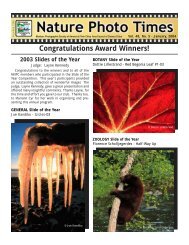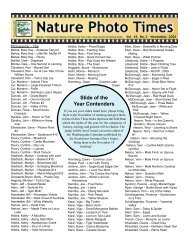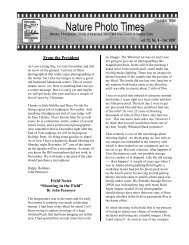Congratulations Award Winners! - Minnesota Nature Photography ...
Congratulations Award Winners! - Minnesota Nature Photography ...
Congratulations Award Winners! - Minnesota Nature Photography ...
Create successful ePaper yourself
Turn your PDF publications into a flip-book with our unique Google optimized e-Paper software.
Field Notes - Winter <strong>Photography</strong> John Pennoyer<br />
Winter Photgraphy<br />
in <strong>Minnesota</strong>??<br />
Why did I choose the subject of winter<br />
photography for this month’s article?<br />
Because on January 11 th I will be instructing<br />
a workshop on Winter <strong>Photography</strong><br />
at Lake Maria State Park. I<br />
have been busy preparing for that<br />
workshop so the subject is fresh<br />
in my mind and we can always use<br />
a refresher. However, as I am<br />
writing this article at the end of<br />
December, there is virtually no<br />
snow on the ground in the Twin Cities<br />
area. I hope that by the time<br />
you read this article we will have<br />
some snow for all of us to “play”<br />
in. I seem to be one of those rare<br />
individuals who enjoy a normal<br />
<strong>Minnesota</strong> winter. Many of the<br />
State Parks and Park Reserves are<br />
not nearly as busy at this time of<br />
the year. It is possible to photograph<br />
a popular scenic area without<br />
hordes of people around. The<br />
colder it is the better I like it, because<br />
more people will stay home<br />
and sit by the fireplace. I can<br />
spend my time choosing the best<br />
composition and selecting the<br />
right lens based on the scene<br />
rather than on trying to omit<br />
people from the viewfinder. Many<br />
times photographing critters is<br />
easier in the winter than in the<br />
summer. Backyard birds, Northern<br />
Owls, Whitetails, swans, coyotes,<br />
fox, etc. are all easier to photograph<br />
as they search for a winter food supply.<br />
However, the cold and snow does give<br />
the photographer some different challenges<br />
and certain precautions need to<br />
be taken. Understanding your camera’s<br />
exposure meter is essential for successful<br />
winter photography.<br />
All cameras with reflective metering<br />
systems are always calibrated to measure<br />
a neutral tone. Many times this is<br />
referred to as 18% gray, neutral, or EV<br />
0. If a photographer is metering a snow<br />
scene and takes the photo at the metered<br />
calibration (EV 0), the pretty white<br />
snow scene will be a dirty gray. To counteract<br />
this problem, the photographer<br />
6<br />
needs to make Exposure Value compensation<br />
for this snow scene by “opening<br />
up” the Exposure Value. Allowing more<br />
light to enter the film plane will allow<br />
the snow to be white. How much to open<br />
up totally depends on the amount of<br />
light you are working with and what<br />
other contrast subjects are in the scene.<br />
I usually start at EV +1 and work my way<br />
to EV +2, however most of my snow<br />
scenes are shot at anywhere from +1 1/<br />
3 to +1 2/3. You will need to experiment<br />
with your own camera system to<br />
understand how its metering system<br />
best captures “white snow”. Also if a<br />
bird or animal is in the scene, let’s say<br />
a Great Gray Owl, there is contrast between<br />
the gray bird and the white snow.<br />
There are two ways to compensate for<br />
the difference in values. With Matrix/<br />
evaluative metering the white snow will<br />
fool the meter and the gray bird will be<br />
very dark, so the photographer will need<br />
to open up to overexpose the scene and<br />
the bird will be the correct gray. The<br />
<strong>Nature</strong> Photo Times<br />
exposure value may have to be set at<br />
approximately EV +1. The other choice<br />
is to spot meter the bird and shoot at<br />
EV 0, because the gray bird is pretty<br />
neutral. Either method will work. The<br />
most important subject is the bird, so<br />
expose correctly for the bird and let the<br />
exposure for the snow fall where<br />
it may.<br />
At -10 F to -15 F and no wind<br />
I think that I can stay outside<br />
all day if I am snowshoeing and<br />
stopping occasionally to take a<br />
photo. If I am in my blind I am<br />
good for maybe 3-4 hours, but I<br />
am dressed properly for this<br />
type of temperature. Here are<br />
some tips for cold weather photography<br />
that I use to protect<br />
myself and my camera equipment:<br />
Legs<br />
I run almost every day and have<br />
run at -25 F with no wind in total<br />
comfort. When I photograph<br />
in cold weather my running<br />
tights are the first things I put<br />
on, then I layer after that. In<br />
my opinion there is nothing<br />
warmer for my legs.<br />
Hands<br />
First, I put on a thin pair of<br />
gloves, then heavier fingerless<br />
gloves and then I have my<br />
hands in a pair of heavy leather<br />
wool lined mittens. (I also have<br />
in my pocket a chemical hand heater<br />
that you can buy at sporting goods<br />
stores)<br />
Head<br />
A wool stocking cap with ear and neck<br />
protection<br />
Feet<br />
Sorel or Pac type boots - I wear two pairs<br />
of socks, a cotton pair and a heavier<br />
wool pair.<br />
Camera Equipment:<br />
• Snow/rain: Always keep your equipment<br />
covered in this type of<br />
weather. Electronic cameras are<br />
very sensitive to moisture. Use a<br />
brush to keep the snow off of your<br />
camera.





